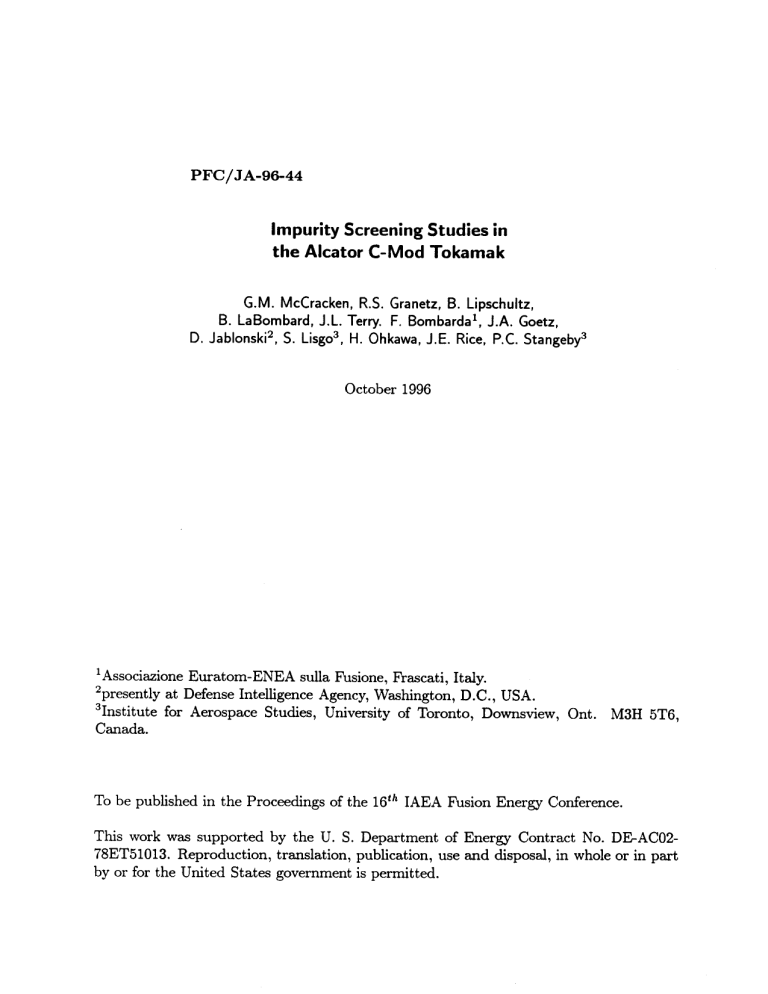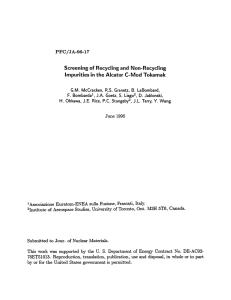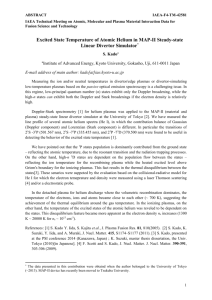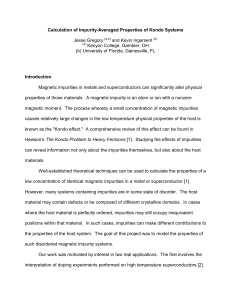Impurity Screening Studies in the Alcator C-Mod Tokamak PFC/JA-96-44 J.E.

PFC/JA-96-44
Impurity Screening Studies in the Alcator C-Mod Tokamak
G.M. McCracken, R.S. Granetz, B. Lipschultz,
B. LaBombard, J.L. Terry. F. Bombarda 1
, J.A. Goetz,
D. Jablonski 2 , S. Lisgo', H. Ohkawa, J.E. Rice, P.C. Stangeby 3
October 1996
'Associazione Euratom-ENEA sulla Fusione, Frascati, Italy.
2presently at Defense Intelligence Agency, Washington, D.C., USA.
3 Institute for Aerospace Studies, University of Toronto, Downsview, Ont. M3H 5T6,
Canada.
To be published in the Proceedings of the
1 6 th IAEA Fusion Energy Conference.
This work was supported by the U. S. Department of Energy Contract No. DE-AC02-
78ET51013. Reproduction, translation, publication, use and disposal, in whole or in part
by or for the United States government is permitted.
Impurity Screening studies in the Alcator C-Mod Tokamak
G M McCracken, R S Granetz, B Lipschultz, B Labombard,
J L Terry, F Bombarda 1 , J A Goetz, D Jablonski, S Lisgo 2 ,
H Ohkawa, J E Rice, P C Stangeby 2 and the Alcator group
Abstract
Screening experiments have been undertaken in both limited and diverted discharges with a range of gaseous impurities in ohmic discharges. Measurements have been made as a function of plasma density and of the poloidal position of gas injection. It has been found that for recycling impurities, such as neon and argon the number of impurities in the core plasma is proportional to the number injected. For non-recycling impurities (carbon and nitrogen) the number in the core is a function of the rate of injection.
For discharges limited on the inner wall the screening is a function of the poloidal position of injection with the injection at the inner wall giving the poorest screening. In diverted discharges with recycling impurities the position of injection does not significantly affect the screening. For non-recycling impurities the screening is typically a factor of 3 better when impurities are injected from the divertor than from the outside mid-plane . However the best screening occurs when the impurities are injected at the inner midplane. Screening is typically a factor 10 better for diverted than for limited discharges.
Impurity transport has been modelled using the Monte Carlo code DIVIMP with a background plasma derived from experimental measurements of plasma parameters at the target and in the Scrape-Off Layer (SOL). It is found that the code can reproduce the experimental measurements within a factor of 2
1. Introduction.
An understanding of impurity transport is important in order that the location and level of radiation in the boundary can be controlled without significant cooling or dilution of the fusion fuel in the confined plasma. A series of experiments has been carried out to investigate the screening effect of the divertor and SOL plasma by injecting recycling (Ne and Ar ) and non-recycling (CH4 and N2) gases into the high density edge conditions in diverted and limited discharges in the Alcator C-Mod tokamak [1]. Compared with studying intrinsic impurities, the use of injected gaseous
1
impurities has the advantage of giving unambiguous knowledge of the source rate and location under a range of operating conditions.
2. Experiment.
The details of the experimental arrangement have been described previously
[1,2]. The impurity gas is injected through a number of capillary tubes entering the vessel at different poloidal and toroidal locations. The carbon, nitrogen and neon radiation in the core plasma is measured with a single spatial channel, scannable
VUV spectrometer [3] and the argon with a crystal spectrometer [4] viewing Ar XVII at up to 5 chords simultaneously. The MIST code [5] is used to calculate the charge state distribution, including transport, and hence the total impurity content. The results are calibrated by the measured brightness of a core impurity line.
The impurity flux in the divertor is monitored with a visible spectrometer using a
2-D CCD detector viewing up to 14 locations at both the inner and outer divertor simultaneously and with a 12 chord bolometer array [6]. In addition there are core measurements of ne, Te, total radiation profiles, Zeff and other spectroscopic diagnostics. The ne and Te profiles in the SOL and at the target plates are measured with a scanning probe and an array of Langmuir probes in the tiles [7]. The impurity injection experiments have been carried out both under conditions where the effect on plasma parameters is small and also where the injection of the impurity has been a serious disturbance, causing the plasma to detach from the divertor target [6]. Typical conditions at the divertor plate vary from Te=20 eV, ne=1x 1019 m3 for the nonperturbative studies to Te=2 eV, ne=2x1 020 m3 for the detached conditions.
3. Results
3.1 Diverted discharges.
(a) Recycling gases
The number of argon atoms inside the separatrix at any given time during the discharge is proportional to the total number injected. Gas has been injected via the capillary tubes into the private flux zone in the divertor, at the inner wall midplane and into the outer SOL, Within the scatter in the data the number of confined atoms is independent of the gas puffing position. The fraction of argon getting into the confined plasma is a decreasing function of density varying from 4% down to 1.5% as the density ne increases from 1 to 2.5x1020. The dependence on divertor geometry has been studied. There is little effect due either to variation of the outer gap or to varying the position of the strike point on the vertical targets [8].
2
(b) Non-recycling gases
In contrast to the rare gases, nitrogen or methane puffs result in an impurity concentration in the confined plasma which decays with a time constant of
-
30 ms at the end of the injection pulse. The time constant is comparable to that measured for impurities injected by laser ablation and indicates an impurity recycling coefficient
0.3. For a long impurity injection pulse the impurity concentration rises to a constant value. The total number of impurities in the plasma is proportional to the impurity
injection rate rather than being proportional to the integrated amount, as is the case for the recycling gases. The penetration factor (PFNR), defined as the impurity number in the confined plasma normalized to the influx (i.e. the impurity particle confinement time) is a characteristic time which varies from < 10-4 s to 10-2 s, depending on species and conditions. Carbon has a lower PFNR than nitrogen [1]
The screening of the non-recycling impurities (both CH4 and N2) is dependent on the poloidal position of gas injection. Screening is best for those impurities injected at the inner wall and in the divertor and poorest for those injected at the outer midplane, fig 1.
Using a fixed nitrogen injection pulse the effect of varying the plasma density in ohmic diverted discharges has been investigated. It is found that PF decreases slowly with increasing density in a similar way to argon. However at densities above about ne = 1.8x1020 m3 the nitrogen injection results in sudden detachment at the outer target. This leads to an increase in the PF by a factor of 2 to 3.
In order to follow the transport of the injected impurities the visible impurity radiation in the divertor has been studied using a visible spectrometer. The charge states Ni (868.0), NII(463.0 nm), NilI (451.5 nm) and Aril (442.6 nm) have been examined. When the N2 gas is injected from either the inside or the outside midplane the Nil and NIhI signals increase. The spatial distributions of the line brightness of NIl and NihI are peaked just above the inner strike point, near the inner divertor "nose".
The spatial distribution of the total radiation is obtained from the bolometer array by tomographic reconstruction. It is found that the radiation is below the X-point distributed along the separatrix, fig 2. The distribution before the nitrogen injection is subtracted from that obtained during injection. The peak radiation is is -5 MW m-
3 .
Evidence of impurity flow in the SOL has been obtained through directly viewing low charge states of carbon and nitrogen at various points of injection [9]. The impurity particle flow is always towards the divertor target, independent of the direction of the toroidal field, even for injection at the inner wall mid-plane.
3
3.2 Limited discharges
The screening of both non-recycling and recycling impurities has been studied for ohmic discharges limited on the inner Mo wall [10]. The limiter plasmas have a slightely smaller elongation (k=1.3) than the diverted plasmas (k=1.6) in order that there is a significant SOL connected to the inner wall limiter. Only limiter plasmas with at least 15mm thick SOL connecting to the inner wall (ie several e-foldings) have been used for the present comparison.
The time behavior of each impurity type is similar to that in diverted discharges, with the impurity density being proportional to the integrated gas injected for recycling impurities and to the injection rate for the non-recycling impurities. Impurities injected into limiter plasmas had a factor 10 to 20 higher probability of penetrating into the core than in attached divertor discharges with as much as 45% of the recycling injected atoms appearing in the confined plasmas. Compared to detached divertor discharges they were only a factor of 3 times worse. These findings were the same for both recycling and non-recycling gases.. Results for argon are shown in fig 3.
Screening in limiter plasmas was found to vary with the poloidal location of the gas puff. Inboard midplane puffing, which bypasses the SOL typically results in a factor 2 to 3 greater penetration than puffing from locations well outside the SOL
4. Modelling
The impurity injection has been modelled using the 2-D Monte Carlo code,
DIVIMP, in combination with the neutral Monte Carlo code NIMBUS [11]. Cross-field transport, parallel transport, ionization and heating are included. So far only nonrecycling impurities have been modelled since this does not require assumptions about the energy and angular distribution of the recycling species. The experimental ne and Te profiles are used as input to an onion-skin model to calculate the ne and Te distribution in the SOL for each discharge. The impurities are launched as atoms with an energy of 0.5 eV, taken as an estimate of the energy resulting from the dissociation of the injected molecular species. Results of the PF are compared to experimental data in fig 1. For a cross field diffusion coefficient D = 1.0 m
2 s-1, agreement between model and experiment is within a factor of 2 except at the inner wall. Less dependence on ne is observed in the model than in the experiment. This low PF may be due to the fact that ionization is taking place far from the separatrix and some of the ions are lost to the wall even before they get to the divertor. Limitations of the present grid prevent these ions being followed.
4
Using the code, the parallel forces on the impurities have been calculated at different radii in the SOL. Near the target the friction force dominates as expected.
Further from the target the ion temperature gradient force drives the impurities away from the target along a field lineack towards the separatrix. From there they diffuse radially outwards and retum to the target [12].
5. Discussion and Conclusions
There is good screening for both recycling and non-recycling gases in diverted discharges; this is attributed to the high plasma density and high power density in the
C-Mod SOL. However while the core density of a recycling species is proportional to the total number of injected atoms and is independent of the poloidal position of injection, the density of a non-recycling species is proportional to the rate of injection and is dependent on the injection position. The screening of both recycling and nonrecycling species is significantly reduced when the plasma detaches from the divertor target. The radial location of ionization is, in all cases, in the SOL. This is partly due to the low energy of the injected gas species.
Screening of non-recycling impurities is best when impurities are injected in the divertor or at the inner wall. The good screening at the inner wall is tentatively ascribed to the sink action of the toroidally continuous wall. Modeling with DIVIMP generally gives good agreement with experiment showing much better screening for impurities injected in the divertor than at the outer midplane. However it does not at present explain the good screening of impurities injected at the inner mid-plane.
Spectroscopic and bolometric measurements of the impurities in the divertor indicate that the radiation is concentrated along the separatrix below the x-point.
The screening of impurities in diverted discharges is about a factor of 10 better than in limiter discharges. However when considering overall performance one must take into account both production of impurities and screening. The lower impurity production of intrinsic impurities at the divertor, when the plasma temperature at the target is reduced below the value corresponding to the sputter threshold, is an additional advantage of divertor operation..
Acknowledgments: The authors are grateful to the whole Alcator team and in particular to the operations group, for the excellent operation of the machine.
5
References
[1] G M McCracken, B Lipschultz, B LaBombard, Controlled Fusion and Plasma
Physics, Proc. 22nd EPS Bournemouth v 11 (1995), 313
[21 G M McCracken, R S Granetz, B Lipschultz et al, J Nuci. Mater. 1997, to be published.
[3] M A Graf, J E Rice, J L Terry et al Rev Sci Instrum 66 (1995) 636
[4] J E Rice and E S Marmar, Rev Sci Instrum., 61 (1990) 2753
[5] R A Hulse, Nuclear Technology /Fusion, 3 (1983) 259
[6] B Lipschultz, J Goetz, B Labombard et al, J. Nud. Mater., 220-222 (1995) 50.
[7] B Labombard, J Goetz, C Kurz et al Phys of Plasmas, 2 (1995) 2242
[8] Y Wang PhD Thesis Plasma Fusion Center MIT 1996.
[9] D. Jablonski, B. LaBombard, G M McCracken et al, J Nucl. Mater. 1997 to be published.
[10] R A Granetz ,G M McCracken, F Bombarda et al
J Nucl. Mater. 1997 to be published.
[11] P C Stangeby and D Elder, J. Nud. Mater., 196-198 (1992) 258
[12] P C Stangeby and D Elder, Nud. Fusion, 35 (1995) 1391.
Figure Captions:
Fig 1. Variation of the Penetration Factor of nitrogen for different poloidal injection positions in attached plasmas at different densities. The injection rate is in the range 2 to 4x10
2 0 atoms s-1.
ie=
1
.
3
-1.5x10
2 0 m-
3
; * iie=1 6-1.9 x10
2 0 m-
3
; x calculated value using DIVIMP, all experimental values of ne
Fig 2. Distribution of radiation in the divertor from bolometer tomography during nitrogen injection.. The radiation before the nitrogen injection has been subtracted..
Shot 951219035
Fig 3. Comparison of argon screening in limiter and divertor plasmas as a function of shot number. Limiter plasmas with argon injection at the outer midplane have a factor 10 worse screening than divertor plasmas .
Ip=
0
.
8
MA, ie=0.
7
2.1x10
2 0 m-
3
.
Run set 950218
6
0
Lf)
CO
- ---------------------------
>0
---------------
---------------
-------
CO
- ----------------
---------------------
:
-----------------
CM
--------------------------- --------------------
-----------------
-------------------------- 6
CM
C)
LO to
- --------------
------------- ---------------------------- ------------------
--------
-------------------------- : -----------------------------
------------------
P-4
2 x 0*
C>
0
0
LO
C)
C; acl Jolord UOTIrAQUOCI
Figure 1
7
OV/019'ogr
E
=-M1 'm- 'O
0
ONE
0 r.-.
0
0 0
0
U)
9;
0
0
Figure 2
8
0.6 k-
Argon
0.4
+
0.2ko Limiter, inboard puff
* Limiter, non-inboard puff
> Divertor, attached
5 10
I
15
Shot Number
1
20
4
25
Figure 3
9
U
*0
ID
(0
0)
(D
I..
30





